1) 鐔 菊花図 無銘 後藤清乗
Design: Chrysanthemum.
SOLD |
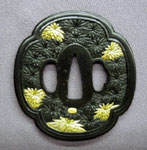 |
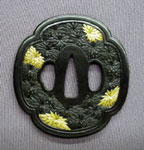 |
1)鐔 菊花図 無銘 後藤清乗
寸法:縦81.0×横76.0×厚さ4.0 (mm)
解説:赤銅地に隙間なく菊が細かく表現されているお目出度い図柄。
五節句の一つである重陽(菊)の節句(9月9日)は宮中の行事の一つで、
詩を詠み、菊花を浮かべた酒を飲むなどしてけがれを払い長寿を願ったという。
江戸時代中期。(18世紀) 特別貴重鑑定書付。
Design: Chrysanthemum. (Symbol of strong life and eternal youth) by Goto Seijo
There is a traditional festival (Choyo-no-Sekku) on 9th September.
We compose poetry and drink a Sake that Chrysanthemum leaves is floating
on the surface for wishing eternal youth in the festival.
18th century. Tokubetsu-Kicho certificate paper.
|
2)鐔 竜田川図 武州住正親
Design: Tatsuta-gawa |
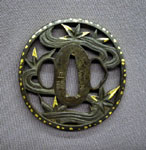 |
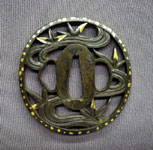 |
2) 鐔 竜田川図 武州住正親
寸法:縦73.5×横70.0×厚さ4.5 (mm)
解説:楓に川の流れを表現したこの図は大和国(現在の奈良県)を流れる日本を
代表する紅葉の名所「竜田川」を表しており日本の秋を感じられる逸品。
構図に動きがあり、耳に金象嵌模様が施されている入念作。
作者は武州(武蔵)伊藤派の鐔工。江戸時代中期。(18世紀)
Design: Tatsuta-gawa. (Red leaves at Tatsuta River where is located in
Nara)
by Bushu ju Masachika.
This river is representative place as sight of red leaves in autumn.
This Tsuba was made by Masachika(Ito School) who lived in Bushu, Edo(=Present Tokyo).
18th century.
|
3) 鐔 米俵図 銘 武陽住一安(花押)
Design: Rice bale. |
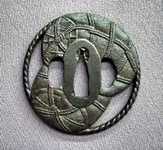 |
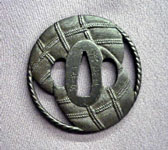 |
3) 鐔 米俵図 銘 武陽住一安(花押)
寸法:縦74.0×横72.0×厚さ5.0(mm)
解説:豊作の願いが込められた図柄で、毛彫りで米俵がよく表現され状態も良い。
大黒天の留守模様としての吉祥の意味も持ち合わせている。
江戸時代後期。(19世紀) 特別保存鑑定書付。
Design: Rice bale. (Design of a good harvest) by Buyo ju Kazuyasu.
This Tsuba was made by Kazuyasu who lived in Buyo, Edo. (=Present Tokyo)
19th century. Tokubetsu-Hozon certificate paper.
|
4) 目貫 稲穂図 割銘 後藤光佐(花押)
Design: Ear of rice.
SOLD |
 |
 |
4) 目貫 稲穂図 割銘 後藤光佐(花押)
寸法:左) 縦36.5×横12.0(mm) 右) 縦36.5×横12.0(mm)
解説:豊作を願い作られたこの豪華な金無垢の目貫は、後藤家12 代光理の
長男『後藤光佐』の作。
病身で若くして隠居したことから作品は少ないという。
本作はキバタ銘で後藤・光佐とそれぞれに銘が刻まれている。
江戸時代中期。(18世紀) 特別貴重鑑定書付。
Design: Ear of rice. (Design of a good harvest) by Goto Mitsusuke.
This elaborate solid gold Menuki is made by Goto Mitsusuke who is son of Goto Mitsumasa
(12th mainline of Goto School).18th century. Tokubetsu-Kicho certificate paper.
|
5) 目貫 瓢鯰図 京金工
Design: Catfish with a gourd. |
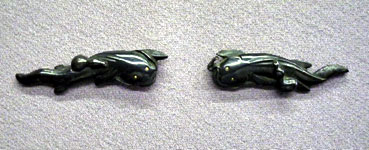 |
5) 目貫 瓢鯰図 京金工
寸法:左) 縦14.0×横52.5(mm) 右) 縦14.0×横52.0 (mm)
解説:鯰に瓢箪の組み合わせを「瓢鯰(ひょうねん)図」といい
鯰を瓢箪で捕らえるという矛盾をどう解決するかという禅の公案(禅問答)を
図案化していると云われている。
赤銅地で大柄の可愛らしい鯰が表現されている。
江戸時代前期-中期。(17-18世紀) 保存鑑定書付。
Design: Catfish with a gourd. by Kyo-Kinko
This motif seems has relation to questions and answers of the Zen (religious meditation).
This Menuki was made by Metal worker in Kyo(=Present Kyoto).
17-18th century. Hozon certificate paper.
|
6) 笄 菊花図
Design: Chrysanthemum. |


 |
6) 笄 菊花図
寸法:縦11.0×横213.0(mm)
解説:菊は香気が高く長寿の植物として古くから天皇家・武家などに愛好されてきた。
特に天皇家では皇室の紋章に用いられていることからも深い関係であることが分かる。
本作は菊が丁寧に表現されている割笄で高級武士等の特注品だと思われる優品。
江戸時代中期-後期。(18-19世紀) 重陽(菊)節句については今月1)の解説文参照。
Design: Chrysanthemum. (Symbol of strong life and eternal youth)
This motif was loved and belonged to Emperor, aristocrat and upper-class
Samurai as
a symbol of strong life and prosperity of own family.
This Kogai (Separate type) seems a special order form upper-class Samurai etc.
18-19th century.
Concerning to the chrysanthemum relationship with Japanese culture,
please see the description of No1 Seijo Tsuba.
|
7) 小柄 御木曳き図 銘 紋廉乗 光美(花押)
Design: “Okihiki” |
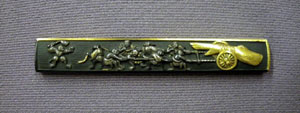
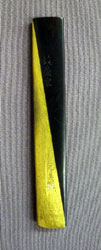 |
7) 小柄 御木曳き図 銘 紋廉乗 光美(花押)
寸法:縦14.0×横96.0(mm)
解説:御木曳きとは伊勢神宮(三重県)で20 年に一度行われる式年遷宮に
際し行うご神体であるご用材を移す伝統行事で、本作ではその様子が良く見て取れる。
近年では平成8年・平成19年に行われた。
式年遷宮とは御社殿を新しくお造りし、ご神宝なども新しく整え、新宮へ遷御いただく
祭儀をいう。
後藤宗家10代廉乗(光侶)の小柄で15代光美の極め。
江戸時代初期。(17世紀) 特別保存鑑定書付。
Design: “Okihiki” (Scene of carrying Japanese cypress for new building) by Goto Renjo, attested by Goto Mitsuyoshi
Okihiki is one of the ceremonies in Shikinen Sengu which is traditional ceremony of Ise-jingu (Mausoleum for ancestry of Imperial family).
This is made by Goto Renjo (Mitsutomo) who is the 10th mainline master of Goto School in 17th century, and it is attested by Goto Mitsuyoshi who is the 15th mainline master of Goto School in 19th century. Tokubetsu-Hozon certificate paper.
|